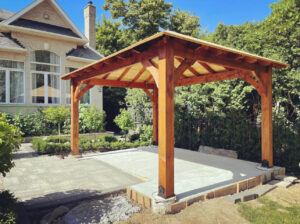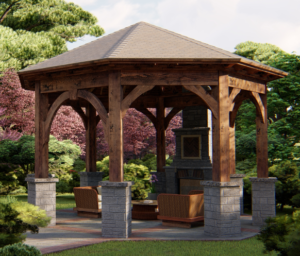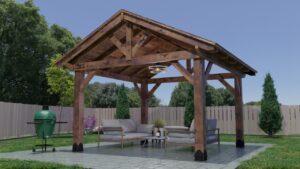Transforming your outdoor space into a year-round haven doesn’t have to break the bank.
Building a pavilion or pergola as part of your DIY patio projects can create the perfect gathering spot for family barbecues, morning coffee, or evening relaxation sessions. With Canada’s diverse climate conditions, designing the right structure for your backyard requires thoughtful planning and the right materials.
Why Choose A Pergola Or Pavilion For Your Canadian Outdoor Space?
Creating an outdoor living space in Canada means dealing with everything from intense summer sun to heavy snow loads and freezing temperatures.
A well-built pergola or pavilion serves as your outdoor room, providing shelter from the elements while maintaining that connection to nature we all crave. These structures can transform an ordinary patio into an extension of your home, perfect for entertaining guests or simply enjoying quiet moments outdoors.
The beauty of DIY patio projects lies in their customization potential. You can design your space to complement your home’s architecture, accommodate your lifestyle needs, and work within your budget.
Whether you’re dreaming of a cozy 8×8 reading nook or an expansive 16×20 entertainment area, the possibilities are endless.
Getting Started On Your Diy Patio Project
Defining Your Vision And Purpose
Before you start shopping for materials or drawing up plans, take time to envision how you’ll use your new outdoor space. Are you creating a dining area for summer gatherings? Perhaps you want a peaceful yoga retreat or a covered space for your outdoor kitchen?
Understanding your primary purpose will guide every decision from size and placement to material selection.
Consider your daily routines too. If you love morning coffee outdoors, positioning your structure to catch the gentle morning sun makes perfect sense. Evening entertainers might prefer western exposure for stunning sunset views during dinner parties.
Site Assessment And Positioning
Your backyard will influence many design decisions. Study how sunlight moves across your yard throughout different seasons. Canadian winters mean lower sun angles, so what seems perfectly shaded in July might be surprisingly bright in December.
Pay attention to prevailing winds, especially if you live in prairie provinces or coastal areas. A well-positioned structure can provide windbreak protection, making your outdoor space comfortable even on breezy days.
Also consider views – you want to frame the beautiful aspects of your landscape while potentially screening less attractive elements.
Also Read: Transform Your Canadian Backyard in 2025: Ideas for Your Pavilions and Pergolas
Material Selection For Canadian Conditions
Wood Options That Stand The Test Of Time
When it comes to wooden pergola construction, not all lumber is created equal in Canadian climates. Cedar remains a popular choice for good reason – it naturally resists rot, insects, and weather damage while developing a beautiful silver-gray patina over time.
Pressure-treated pine offers excellent value and durability, especially when properly maintained with regular staining or sealing.
Compared to other softwoods, Douglas Fir has become a popular choice for pergola and pavilion construction. This type of wood is known for its durability, high strength-to-weight ratio, and affordability. It’s valued for covering longer distances between posts, making it a great choice for bigger or more structurally challenging pergolas.
For sustainability, FSC-certified lumber ensures your project supports responsible forest management. Many Canadian suppliers now offer locally sourced options that reduce transportation impacts while supporting regional economies.
Modern Alternatives: Composite and Metal Solutions
Pergola kits often feature composite materials that combine recycled plastics with wood fibers. These materials require minimal maintenance while resisting fading, warping, and insect damage. While the initial investment might be higher, the long-term savings in maintenance time and materials often justify the cost.
Aluminum and steel structures offer ultimate durability and can be powder-coated in various colors to complement your home’s exterior. These materials excel in areas with extreme weather conditions and can support heavier roof loads.
Foundation and Structural Considerations
Building Below the Frost Line
Canadian building codes exist for good reason, and foundation requirements top the list. Frost heave can destroy improperly installed structures, so concrete footings must extend below your region’s frost line. This typically means digging 1 to 1.5 meters deep in most Canadian locations, though local building departments can provide specific requirements for your area.
Proper footings aren’t just about meeting code – they ensure your structure remains stable and square year after year. Using galvanized or stainless steel post anchors prevents corrosion and makes future maintenance easier.
Framing for Snow Loads
Canadian pergolas and pavilions must handle significant snow loads, especially in regions that receive heavy winter precipitation. This means using appropriately sized beams and rafters with proper spacing. While a 2×6 rafter might work fine in Florida, Canadian conditions often require 2×8 or 2×10 lumber spaced closer together.
Many timber frame kits in Canada provide engineered plans that account for local building codes and weather conditions. These pre-designed systems take the guesswork out of structural calculations while ensuring your project meets safety requirements.
Simple to Sophisticated Design Options
Classic Pergola Styles
Traditional pergolas feature open-beam construction that provides partial shade while maintaining an airy, open feeling. You can customize the spacing between roof slats to control shade levels – closer spacing for dining areas that need more protection, wider spacing for spaces where you want maximum light.
Modern pergola designs might incorporate adjustable louvers or retractable canopies for ultimate flexibility. These features let you adapt to changing weather conditions or different activities throughout the day.
Pavilion Advantages
Pavilions with solid roofs offer complete weather protection, making them ideal for areas with frequent rain or intense sun. Hip, gable, or shed roof designs can complement your home’s architecture while providing covered space for outdoor furniture, grills, or hot tubs.
Consider polycarbonate roofing panels for pavilions where you want weather protection without completely blocking natural light. These materials filter UV rays while allowing diffused sunlight to create pleasant, naturally lit spaces.
Also Read: Designing the Ultimate Outdoor Kitchen with Pergolas and Pavilions
Sizing Your Project for Maximum Impact
Proportional Planning
The key to successful DIY patio projects lies in proper proportioning. Your new structure should complement your existing landscape without overwhelming it. As a general rule, avoid covering more than one-third of your available yard space to maintain good airflow and preserve open lawn areas.
For intimate spaces, an 8×8 or 10×10 structure provides enough room for small seating arrangements or bistro tables. Growing families or frequent entertainers might prefer 12×16 or larger structures that accommodate dining sets, lounge furniture, and circulation space.
Multi-functional Design
Consider designing your space for multiple uses throughout different seasons. A structure that serves as a dining area in summer might become a covered storage space for patio furniture during the winter months. Built-in benches can provide seating during parties and storage for cushions or gardening supplies.
Permits and Code Compliance
Never skip the permit process, even for seemingly simple structures. Local building departments can provide valuable guidance about setback requirements, height restrictions, and structural specifications. Permit fees represent small investments compared to the potential costs of rebuilding non-compliant structures.
Most Canadian municipalities require utility locates before digging, protecting you from dangerous and expensive encounters with buried gas, electrical, or water lines. This free service prevents accidents and costly repairs.
Conclusion
The key to success lies in thoughtful planning, quality materials, and building to local standards.
Whether you choose a simple wooden pergola or an elaborate pavilion with all the amenities, your new outdoor space will become a cherished extension of your home where family and friends naturally gather to enjoy the best of Canadian outdoor living.At Norweh, we understand the importance of family. Contact us today, and we’ll ensure you get the perfect pergola to create lasting memories with your loved ones.











